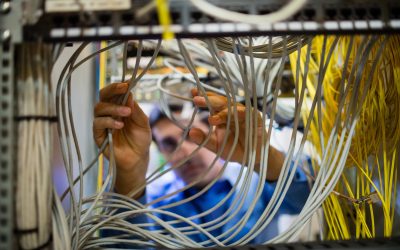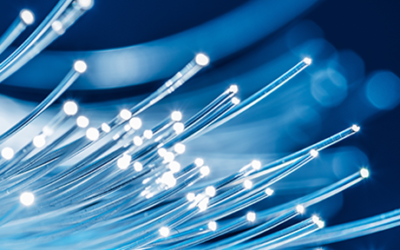Network Trends, Bandwidth Needs, Infrastructure Decisions

Dramatic increases in computing performance over the years continue to be reflected in the network traffic they generate. The potential of devices to utilize network bandwidth is still far from fully realized by current software, but the upward trend is clearly evident. Device’s growing ability to handle voice, video and multimedia, as well as data, is causing all these elements to converge on the same networks. This convergence, combined with rapid growth in the individual areas, is increasing demand for network capacity. In turn, pressure on wired and wireless infrastructure is also growing, and decisions on its future are becoming more important to a network’s survival and success.
Teleworking and co-operative working are also on the increase in order to improve productivity and reduce costs. Together with increased emphasis on travel avoidance, these developments are creating demand for video, audio and data conferencing. Such applications, together with on-line computer-based training, consume network capacity on a scale that dwarfs the requirements of most current business software.
Whatever network application is chosen in response to these developments, the wired and wireless infrastructure will be an increasingly vital investment. Network infrastructure is the central nervous system of any organization and must be fit to meet the bandwidth challenge.
Factors Driving Network Bandwidth
Progress is relentless; new technologies spur new application development, and new applications, in turn, fuel the need for further technology advancements. In a relatively short time span, network connections have evolved from shared or switched Ethernet to switched Fast and Gigabit Ethernet to accommodate rising bandwidth demand. Within the enterprise networks, business applications are now advancing to embrace high-resolution graphics, video, and other rich media types that exceed the capacity of even Gigabit Ethernet performance.
Large enterprises are also faced with a growing need for higher bandwidth in the horizontal and backbone to support such applications as Storage Area Networks, Network Attached Storage, high-performance and edge computing.
Network administrators need to find a way to accommodate these increasing application and user bandwidth demands on network capacity, while keeping cost and complexity down.
Optimizing the Cost per Bit
Our insatiable appetite for increased bandwidth is fed only at the right price. The benefits of using higher performing wired and wireless infrastructure is that substantially lower cost per bit is facilitated when using the better network, but is this a driver for IT users today? If we explore the trends in other key areas of IT, it is soon clear that this benefit is meeting the demands created by other key IT market drivers and is a fundamental requirement of any infrastructure choice.
The information technology industry is preoccupied by the growth in bandwidth and the search for larger pipes from service providers. A fundamental challenge for the industry is the impact of radical and market disrupting technologies on the cost structure of transporting a bit a kilometer. Three basic technologies – microelectronics, storage, and photonics – are disrupting the communications market place.
These technologies along with the universal use of IP networks are driving the march to next generation networks. Putting them together leads to service provider wars, and only the infrastructurally enabled will survive. The industry is embracing a supply side approach — limitless bandwidth based on the lowest operational cost of transporting a bit a kilometer.
If we extend these trends from the Wide Area Network (WAN) to the Local Area Network (LAN), every 5-6 years we need to add another zero on the LAN data rate but also match the trend in reduction of cost per bit. We need to put in the most power and bandwidth we can justify, knowing it will quickly be consumed. Our imagination of how it will be consumed is only limited by our wallet. The statement “I want it” gets balanced with “can I afford it”. Once the degree of need overcomes the price/affordability hurdle, the purchase is made.
Network departments are seeking to rid network architectures of costly and increasingly unnecessary hierarchies, while optimizing their networks to eliminate delay and latency. Like the virtually free transistors on a microprocessor, latency-free networks and virtually free bits will spur the development of new applications with foundations in telemetry, Video-WEBs, virtual and augmented reality applications, and so forth. When transport costs are no longer a barrier to market adoption, the demand for these applications will mushroom – resulting in a second order impact of increased capacity demand. Virtual presence will be achievable to a far greater degree than at present. Supplemental information superimposed on real time information will be more common. Businesses will export themselves to the consumer in a far more compelling and immersive way that is common in today’s E-commerce.
Application Bandwidth Needs and Directions
Let’s take a more detailed look at the type of applications becoming prevalent and their bandwidth needs. Network applications can be divided into two classes, file transfer and real-time streaming media.
File Transfer
These applications include downloading files from a server to a user’s desktop device (or vice versa). In many cases the user or device must wait for the file transfer to complete before allowing the user to act on the file. If a file transfer takes too long, the user may find the delay unacceptable and may also lose productivity. It is the user’s subjective reaction that determines what data rate is acceptable.
The need for file transfers is increasing, driven by several related trends:
- Internet access: This ever-growing application area continues to stimulate carrier and enterprise LAN traffic. Downloads and uploads to and from web applications is increasing the burden on network bandwidth especially as Internet file sizes continue to increase.
- Thin-client architecture: Thin-client PCs have operating systems with small (or no) hard drives, so that software application and data files must be downloaded from a server before the user can start working. Sometimes known as network computers, these machines reduce the administrative overhead for IT organizations. Acceptance is increasing as enterprises look to protect their data centrally.
- Client/server applications: In these applications, the software application resides on a client PC while associated data is stored on a server. The server-resident data (or extracts from the data) must be downloaded to a client for processing and presentation to the user.
- Database downloads from servers: Spreadsheets, documents and databases may be located on servers, and then downloaded to a device before they are viewed or processed. Leading-edge applications include:
- Data warehousing and back-up applications – may include terabytes of enterprise information distributed on hundreds of network servers and accessed by thousands of users seeking near-real-time data. The load impacts the LAN backbone and the WAN, where traffic is aggregated.
- Scientific and engineering applications – examples include: 3-D visualizations of complex objects ranging from molecules to aircraft; full-color publications sent from desktops to printing facilities; transmittal of complex medical images to enable sharing of expensive equipment.
The size of files transferred vary over many orders of magnitude and the time it takes to transfer the information is linked primarily to the data rate of the network.
Real-Time Streaming Media
These applications, such as desktop video teleconferencing and Internet radio/TV, require that sound (e.g., voice, music) and moving images (e.g., video, animation) be sent in real time. These streaming applications involve the transmission, reconstruction and presentation of information to a desktop user. In order to preserve the appearance of continuous sound or image, such applications are delay-intolerant, providing real challenges for network equipment developers and network designers. But for network infrastructure, the medium simply must carry data at an adequate rate.
Data compression techniques have reduced the bandwidth requirements by an order of magnitude while network data rates have steadily increased. The degree of compression that is acceptable depends on the quality desired for the sound or image. Various algorithms are available that allow developers and end users to tune the degree of compression to an application’s requirements, but there is always a cost in terms of quality. The other penalty is latency – sophisticated compression schemes increase latency that is burdensome for real-time 2-way video interactions.
Multimedia applications are made up of individual elements that have widely different information transfer properties. For example, printed text requires the reader to scan sequences of code and reconstruct the code into words, sentences and paragraphs. While vision is capable of perceiving a large amount of material instantly, it is not efficiently utilized for text-oriented data. As elements become more graphic, the information they contain becomes easier and faster to process. The following paragraphs summarize the estimated data rates required to run various network multimedia applications at acceptable levels of performance and illustrate the need for gigabit networking.
Still images most often refer to photographic reproductions of existing objects. There is a famous saying ‘A Picture Paints A Thousand Words’. A still image can transfer information faster than text, since human beings process visual information much faster than written information. Photographs can be created digitally or converted to a digital format, usually through a scanning process. A photograph can contain millions of color variations, which can be recreated in digital format. Since image files tend to be large, especially if millions of colors are used, they benefit from compression techniques. Many compressed file formats are used for the storage of digital still images.
Let’s consider the data rate requirements for these applications. At 1200 dots per inch (dpi), an 8½ inch x 11 inch page translates into (8.5 x 1200) x (11 x 1200) = 10200 x 13200 = 134,640,000 dots. If the 8½ inch x 11 inch page is a grey scale image that uses 256 shades of grey, each dot represents one byte of storage space. Therefore, the whole image requires 134,640,000 bytes or 134.6 MB of storage space, uncompressed. Even with compression, if many such images were expected to be simultaneously transmitted over a network during normal operations, the network must be specifically designed to accommodate such traffic.
While imaging and graphics software generate large data files, audio and video applications create larger ones, even after compression algorithms have been applied.
Audio is a dynamic element that can be used to enhance multimedia applications in many different ways. Uses for audio include the following:
- Voice recognition of computer commands
- Spoken help functions
- Voice-annotated documents
- Voice-annotated e-mail messages
- Sound effects associated with video and animation
- Music
The use of sound contributes to a more realistic representation of information. Capturing and converting audio into digital format can result in very large files, especially if compact disc (CD)-quality sound is desired. The ultimate size of the captured audio file depends on four factors:
- The length of the audio clip
- The sampling rate – 11, 22, or 44 kilohertz (kHz)
- The number of bits used to represent each sample – 8 or 16 bits can be used
- Whether the recording is stereo or mono-stereo sound produces a file that is twice the size of a mono file, since two channels must be recorded.
For CD-quality sound, the recording must be in stereo, with a sampling rate of 44,000 hertz (44 kHz) and 16 bits used for each sample. Therefore, a one-minute recording of this type requires over 10 MB of disk storage capacity. The calculation is as follows:
44,000 samples/second x 16 bits/sample x 2 = 1,408,000 bits/second = 1.408 megabits/second
1.408 megabits/second x 60 seconds/minute = 84.48 megabits/minute
With 8 bits/byte, this leads to approximately 10 MB/minute.
At 1.408 Mb/s each, multiple CD-quality sound files played over a network simultaneously can quickly use up a considerable amount of bandwidth. Alternatively, downloading as a full CD sound file takes considerable bandwidth to undertake in a timely fashion.
Video is the element most often associated with the term multimedia. It can be used in real-time telecommunications (e.g., a video conference) or captured and stored for later use (e.g., a video clip in a digital document). The ability to digitize video has enabled audiovisual technologies associated with film and television to be deployed in any office. The communications channel capacity and storage requirements for transmitting and storing digital video are the most demanding of the multimedia elements. One minute of high-quality uncompressed video can consume 500 megabytes (MB) of storage space
Expanding the earlier saying ‘A Video Portrays A Thousand Pictures’, video is a sequence of frames (still images) played back in rapid succession. In the case of digital video, the screen images displayed are in a digital format made up of many individual dots or pixels. Video graphics array (VGA) monitors can display resolutions of 640 pixels across by 480 pixels down, up to ultra video graphics array (UXGA) resolutions of 1600 pixels across by 1200 pixels down. To digitally display true, photo-realistic color, each pixel requires three bytes of storage – one each to describe the red, green, and blue (RGB) color components of each pixel. Therefore, the 1600 x 1200 pixel display showing full screen video that is uncompressed would require 5,760,000 bytes (1600 pixels x 1200 pixels x 3 bytes/pixel) of information to display one frame of video. In reality, most video is transmitted compressed using standards based encoding schemes such as MPEG4 (Motion Picture Entertainment Group) that require a fraction of the digital information required for uncompressed, but there are a growing number of applications such as medical CAT scans, X-Rays and entertainment formats that require this uncompressed capability.
The perception of motion occurs when a series of frames are displayed in rapid succession known as the refresh rate. For example, standard analog television displays use a refresh rate of 30 frames per second (25 frames per second in many parts of the world). Higher resolution applications such as VGA require analog refresh rates more than double that, in the order of 72 frames per second. To achieve this digitally uncompressed over a data network would require a data throughput of 8 bits/byte x 5,760,000 bytes/frame x 72 frames/second = 3.3 Gb/s.
At 3.3 Gb/s, it is clear that constant digital video traffic would rapidly cause most networks to fail due to congestion, especially if document sharing and text/image file transfer is added and occurring at the same time in real-time. Gigabit networking is fully justified for these applications, but what about others to be deployed in the future:
The success of multimedia applications can be a double-edged sword for network managers. State-of-the-art multimedia, Internet and groupware applications can bring the enterprise major advances in productivity and cost savings. At the same time, these applications can tax the bandwidth needs of even the most robust networks, applying pressure at the user device, the server and the switch, while creating higher capacity demands at the network core.
Infrastructure Implications
Due to the hierarchical nature of the LAN and the “funneling” effects of LAN switching, the “need for speed” clearly grows the further one gets out from the user. The natural evolution for the general business LAN over the next few years will involve a migration to switched Gigabit to the user, switched 10 Gb/s capability first at the server interface and then in the building backbone, and finally switched 100 Gb/s capability in the mainstream enterprise environment. The infrastructure portion will experience a similar migration over the same time period, with high performance copper cabling and wireless strongly positioned as the horizontal medium, laser optimized multimode fiber in the building backbone and singlemode fiber in the campus/wide area.
The critical factor in choosing the right infrastructure option is anticipated demand on network capacity. For a system that should not need replacement for many years, demand that is easily foreseeable today is only part of the picture.
Based on past experience, the only prediction to be made about entirely new network-centric applications, beyond the five-year horizon, is that they are unpredictable. Nevertheless, it is certain that new applications will arrive and that the existing network will be expected to cope with them. This unpredictability is the basis for the most powerful argument in favour of a large surplus in the capacity of any new network infrastructure installation.
Networks need a coherent, long-term wired and wireless strategy in order to reap the full benefits of new networking technology.
For education resources on wireless and network infrastructures, take a look at the Cabling Science Institute’s catalog.

Written by James Donovan
You might also enjoy
FO Connector Contamination – A Constant Threat
Fiber optic communication most commonly works in duplex or multifiber transmission by transmitting light to a receiver in one direction on a fiber and receiving transmitted light back to a second receiver on the second fiber. Most engineers can understand that and...
Why Inspect and Clean Fiber Optic Connectors?
Inspecting and cleaning of fiber optic connectors during installation and when making any patching, is essential. Any contamination on a patch cord connector will be transferred through the coupler to the connector it is mated to. Even when testing fibers with a test...
Cleaning MPOs
MPO connectors should always be inspected with a scope before they are used, be that on a patch cord or a bulkhead. If they need to be cleaned, one-click cleaners are keyed to ensure the tip only fits one way onto the connectors and is able to clean both male and...


